The cost of concrete batching plant is a key factor for anyone planning to start a concrete production business. It’s not just about the price of the equipment—land, installation, permits, labor, and daily operating costs all add up. In this guide, we break down every expense so you can create a clear budget, plan your investment wisely, and avoid unexpected costs.

Core Factors Affecting Concrete Batching Plant Cost
When planning to invest in a concrete batching plant, understanding the key factors influencing cost is essential. These factors determine both the initial investment and long-term operating expenses, helping investors choose the most suitable plant for their projects.
Stationary Type Batching Plants – For Long-term Projects
Permanently installed, suitable for high-volume, long-term projects. Require foundations and more site preparation, which increases upfront costs but ensures stable, low-cost operation. Our AJ series stationary concrete plants can be classified into belt and hopper types based on their feeding methods. Their capacity can reach 240 m³/h or more, accommodating various project requirements.


Key features of our stationary plants:
- Integrated Control System: Supports both PLC touchscreen and physical button operation, adapting to different user habits, reducing manual dependency, and improving response speed.
- Real-Time Dashboard: Monitor motor temperature, vibration, and current; automatic alerts and diagnostic reports for anomalies.
- Predictive Maintenance: Intelligent maintenance schedules based on runtime and wear data to reduce unexpected downtime.
- Precise Feeding System: Improves production continuity by 20% and reduces material waste by 10%.
- Remote Control & Auto Calibration: Adjust feed speed and ratios via mobile devices; supports material level alerts and auto-refill.
- Customizable Design: Quickly adapts to mining, infrastructure, and ready-mix scenarios, boosting equipment utilization by 35%.
Mobile Type Batching Plants – For Quick Installation and Relocation
The mobile plant with wheeled mobility allows for convenient site relocation. It reduces dismantling costs and time, as disassembly can be completed in half a day and the equipment can be transferred to a new site within one day. Aimix mobile concrete plants primarily consist of the AJY and AJSY series, with capacities reaching up to 120 m³/h to meet different project demands.
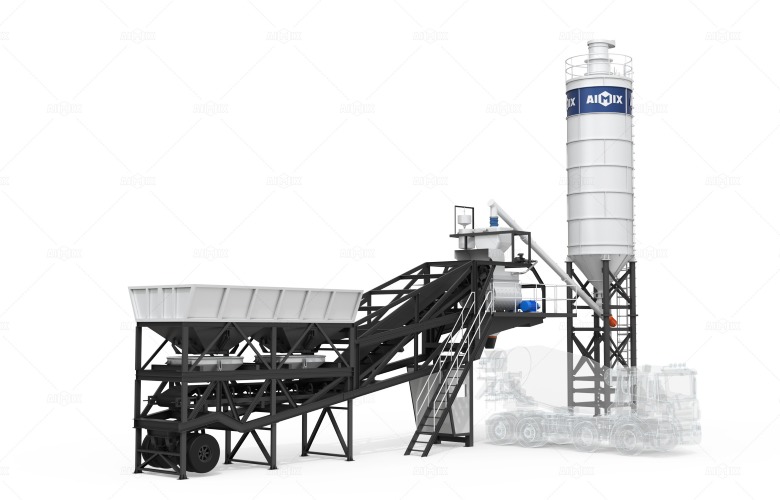

Production Capacity
- Small Plants (20–50 m³/h): Suitable for small-scale projects or startups, with lower investment but limited output.
- Medium Plants (60–120 m³/h): Balanced choice for mid-sized infrastructure or commercial projects, offering reasonable efficiency.
- Large Plants (120 m³/h+): For large infrastructure or industrial-scale production; higher initial cost but lower unit cost per cubic meter.
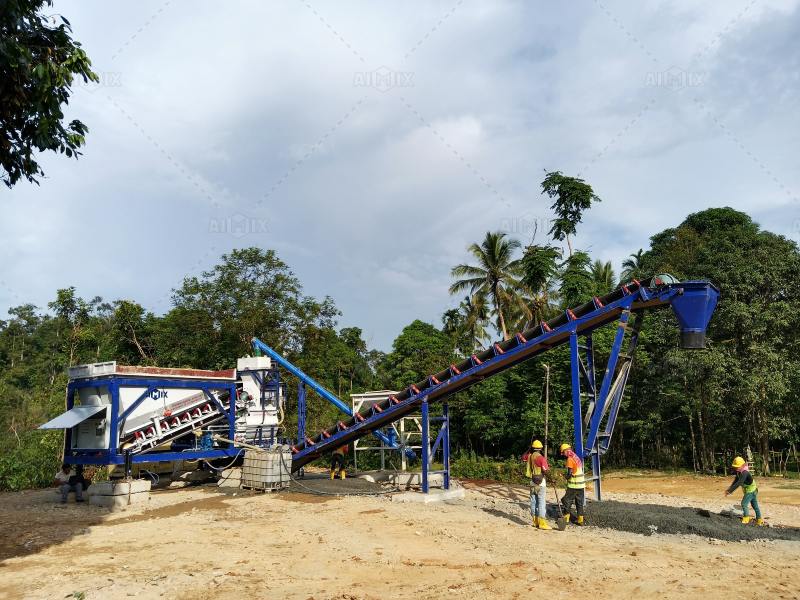
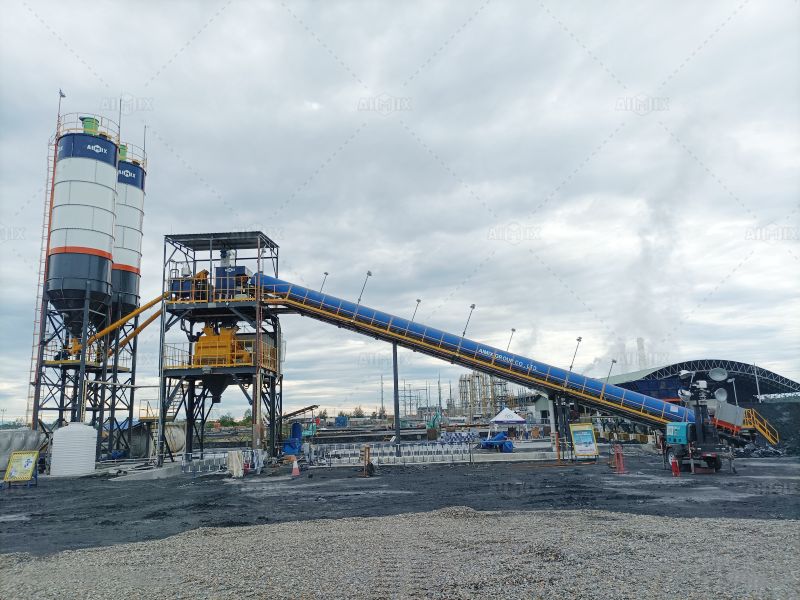

Level of Automation
- Manual Plants: Lowest initial cost, higher labor requirements, and potential mix inconsistencies.
- Semi-Automatic Plants: Moderate investment, partially automated for improved efficiency and fewer errors.
- Fully Automatic Plants: Highest purchase price but minimal labor, precise mixing, and faster ROI. We provide different fully antomatic batching plants to suit various project needs.
Mixer Type
- Twin-Shaft Mixers: Twin-shaft mixers provide high capacity and are ideal for large-batch concrete production, designed to meet complex conditions and diverse production requirements.
- Mixers: Premium option for high-quality or precast concrete; ensures exceptional uniformity and performance, suitable for fine aggregates.
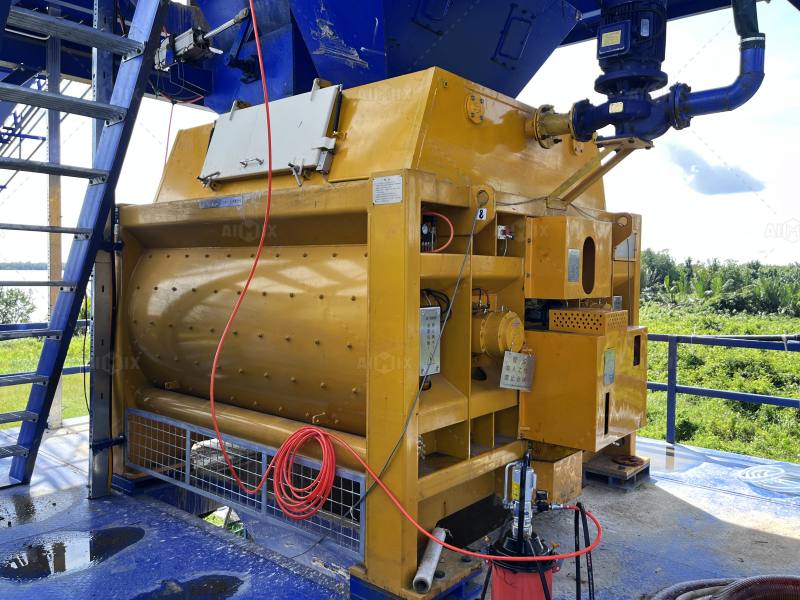
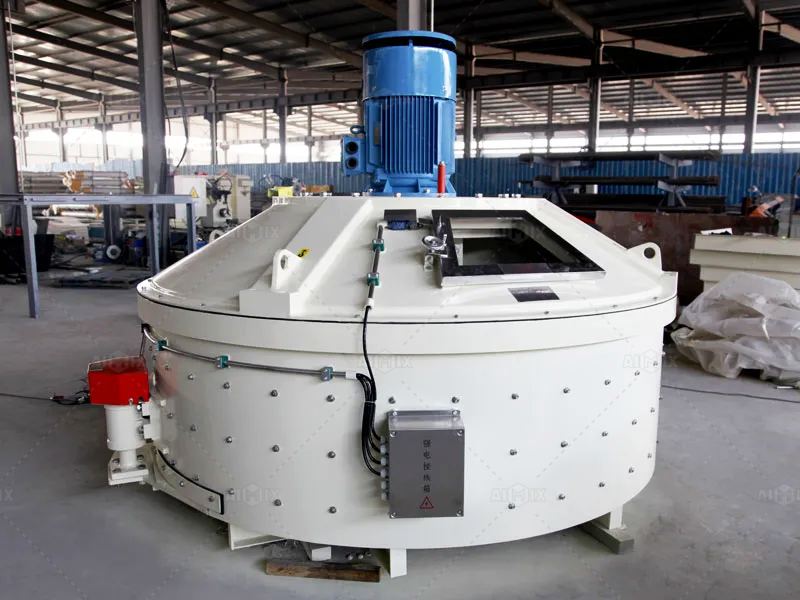
Brand Influence
Brand affects pricing due to quality, technology, reliability, and after-sales service. Premium brands cost more but provide durability, advanced features, and better long-term support.
Detailed Cost Breakdown of a Concrete Batching Plant
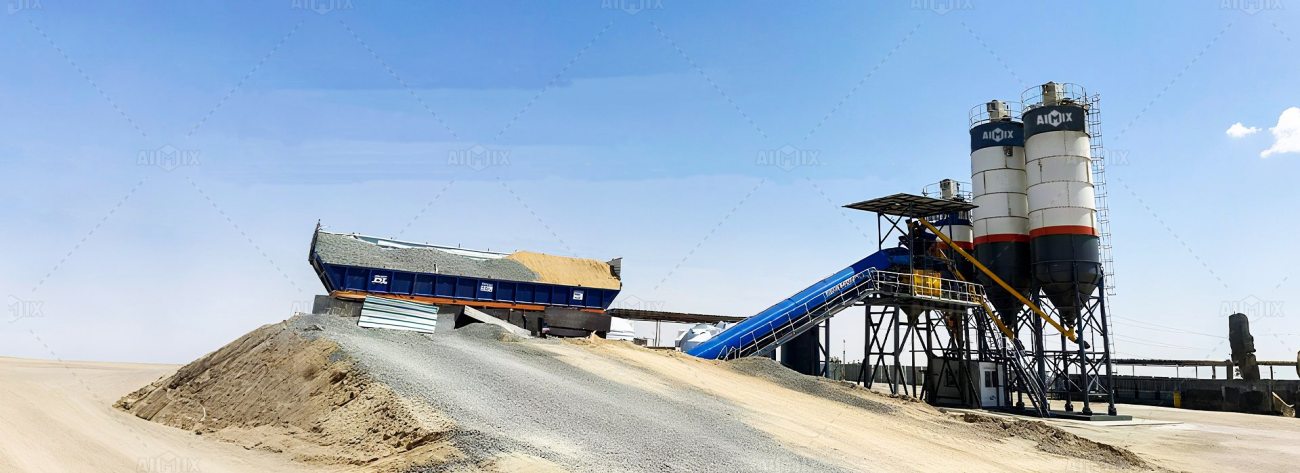
How much does a concrete batch plant cost? Understanding the cost of a concrete batching plant involves more than just the equipment price. Investors should consider all components, from setup to operation, to create an accurate budget. Below is a detailed breakdown of key cost elements:
Equipment & Plant Base Price
- Fixed Plants (AJ25–AJ180 m³/h): $33,000 to $210,000 or more
- Mobile Plants (AJY25–AJY90 m³/h): $38,000–$120,000
- Compact Plants (AJSYseries): $30,000–$50,000
Installation & Setup Costs
Stationary concrete plants need solid foundations, site preparation, and assembly, adding 10–20% to costs. Mobile batch plants are quicker to install with lower setup expenses, suitable for flexible or remote projects.
Land & Infrastructure
Land costs vary by location, with urban areas typically more expensive. Expenses also include site layout, drainage, electricity, and space for storage, all necessary for efficient plant operation.
Labor & Training
Skilled operators and staff are essential for safe, efficient production. Training and installation support usually cost $2,000–$10,000, depending on plant size, complexity, and automation level.
Permits & Compliance
Environmental, construction, and operational permits are necessary to meet regulations, avoid fines or shutdowns, and ensure long-term, legally compliant plant operation.
Operational & Maintenance Expenses
Daily operation costs of concrete batching plant include electricity or fuel, routine maintenance, spare parts, and labor, generally accounting for 10–15% of annual plant expenses while ensuring consistent performance.
Optional Upgrades & Add-Ons
Automation, dust collection, extra silos, or advanced monitoring systems can increase productivity, safety, and compliance. Budgeting 5–15% extra for these improvements is common.
Investment Return Analysis of Concrete Batching Mixing Plants

The concrete batching plant market is growing due to more building projects, city expansion, and eco-friendly rules. New technology like automation, smart monitoring, and green systems makes plants work faster and save money. By making concrete in-house and serving different needs, a concrete plant can bring high profits and long-term business growth.
Market Demand Driving Investment Returns
The global concrete batching plant market was valued at USD 2.5 billion in 2023 and is projected to reach USD 3.8 billion by 2032, growing at a compound annual growth rate (CAGR) of 4.73%. This growth is driven by:
- Infrastructure Development: Increased government spending on infrastructure projects boosts the demand for concrete.
- Urbanization: Rapid urbanization leads to higher demand for residential and commercial buildings.
- Environmental Regulations: Stricter environmental laws encourage the adoption of eco-friendly batching plants, expanding market opportunities.
Technological Advancements Enhancing ROI
Advancements in technology play an important role in improving the efficiency and profitability of concrete batch plants:
- Automation: The integration of automation in batching plants enhances production efficiency and reduces labor costs. For example, Aimix batching plants feature an integrated control system with one-click start/stop and dual operation modes, cutting startup preparation time by over 30% and reducing operational errors by 50%, ensuring continuous production.
- Digitalization: IoT-enabled systems allow for remote monitoring and control, leading to better resource management and reduced downtime. Aimix concrete plants’ IoT remote control system enables real-time monitoring of equipment status, reducing failure rates by 40%, cutting maintenance costs by 25%, and extending equipment lifespan by over 15%.
- Sustainability: Adoption of green technologies not only complies with regulations but also attracts environmentally-conscious clients, potentially commanding higher prices for eco-friendly concrete.
Economic Benefits and Profitability
Investing in a batching concrete plant offers several economic advantages:
- High ROI: With proper management, concrete batching plants can achieve substantial returns. For instance, a study on a Sigli-Banda Aceh highway project indicated an internal rate of return (IRR) exceeding 40%.
- Cost Savings: Producing concrete in-house eliminates the markup costs associated with purchasing from external suppliers.
- Diversified Revenue Streams: Batch plants can produce various types of concrete, catering to different market segments and increasing revenue potential.
Cost Optimization and Efficiency Strategies for Concrete Batch Plants
Running a concrete batch plant profitably takes more than just managing the purchase cost of the batching plant—it requires smart, efficient operation. By applying effective cost-saving and productivity-boosting methods, operators can produce more concrete at a lower cost per cubic meter and maximize ROI. This section shares practical tips from technical, operational, and management angles.
Choose the Right Plant Type and Capacity
Selecting the appropriate type of concrete plant is the first step in cost optimization.
- Stationary vs. Mobile Plants: Stationary batching plants suit large, continuous projects, while mobile plants offer flexibility for multiple sites.
- Match Plant Capacity to Demand: Over-investing in high-capacity equipment can increase costs unnecessarily. Under-capacity plants may limit production and affect delivery schedules.
Proper selection ensures lower initial investment cost of concrete batching plant and more efficient operation.
Optimize Production Efficiency
Maximizing output without increasing costs is key to reducing the average cost of concrete.
- Optimize Material Properties: Adjust water-cement ratio or use suitable admixtures to reduce viscosity. Lower viscosity prevents material sticking to mixers or conveyor walls.
- Reduce Conveying Distance and Inclination: Shorter conveyor paths and smaller slopes reduce energy consumption and material loss.
- Optimize Equipment Speed: Set conveyor and mixer speeds based on optimal production rates rather than maximum speed.
- Real-Time Monitoring: Use sensors to track particle size, temperature, water content, and abrasiveness. This ensures consistent concrete quality and reduces waste.
Evaluate Automation vs. Labor Costs
Automation significantly impacts efficiency and cost control.
- Fully Automatic Plants: Reduce labor requirements and ensure mix consistency but have higher upfront costs.
- Semi-Automatic Plants: Offer a balance between price and efficiency.
Operators should compare long-term labor savings against initial automation investment to identify the most cost-effective solution.
Source Reliable Suppliers with Local Support
Working with suppliers that provide installation assistance, spare parts, and after-sales service is crucial.
- Faster Maintenance: Local support reduces downtime and repair costs.
- Continuous Operation: Quick response to technical issues ensures stable production.
Reliable batching plant suppliers help maintain efficiency and lower operational costs. As a strategic partner of Fortune Global 500 companies, Aimix has collaborated with clients worldwide and established many overseas offices and service centers to provide faster and better support.
Plan Site and Infrastructure Efficiently
The layout and infrastructure of a concrete plant directly affect operational costs.
- Foundation and Utilities: Proper foundation design and easy access to water and electricity prevent future issues.
- Material Storage and Transport: Efficient storage and short transport distances reduce energy consumption and increase daily output.
A well-planned site ensures smoother operations and better cost management.
Maintain Equipment Regularly
Preventive maintenance is essential to reduce long-term costs.
- Regular Checks: Routinely inspect mixers, conveyors, and motors to identify potential issues early and ensure stable, high-quality concrete production consistently.
- Reduce Repairs: Keeping all equipment properly maintained helps prevent unexpected breakdowns, reducing downtime and costly emergency repairs on-site.
- Extend Lifespan: Regular maintenance and timely servicing of machinery prolong equipment life, lowering replacement frequency and saving long-term operational costs of concrete batching plant.
Consider Optional Upgrades Strategically
- Useful Add-Ons: Installing dust collection systems, advanced monitoring tools, and additional storage silos can enhance plant efficiency, improve safety, and maintain consistent production quality.
- Cost-Benefit Analysis: Evaluate each optional feature carefully, investing only in equipment or systems that clearly increase production efficiency, reduce costs, or boost profitability.
- Strategic Upgrades: Thoughtfully planned upgrades strike a balance between initial investment and long-term benefits, maximizing overall return on investment and operational performance.
How Aimix Supports Your Concrete Plant Business from Start to Success
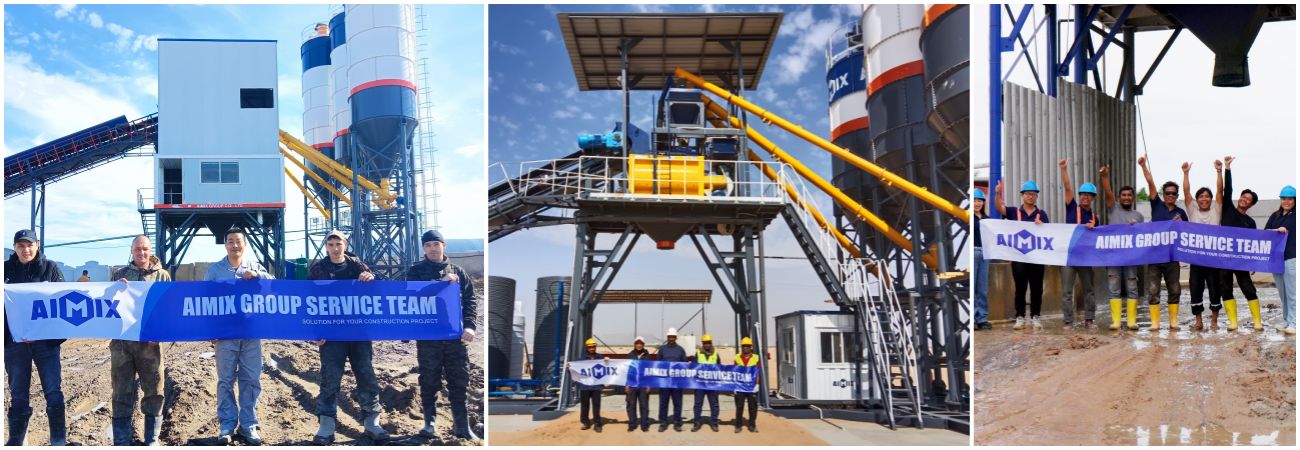
Starting a concrete plant business can be challenging, but Aimix offers full support to help investors run smoothly and profitably. From choosing the right concrete batching plant to ensuring efficient long-term operation, we guide you through every step.
Professional Plant Selection and Customization
Choosing the right concrete plant is the foundation of a successful investment. We evaluate your project scale, site conditions, and budget to recommend the most suitable batching plant type and capacity. Whether you need a stationary, mobile, mini, or fully automatic plant, Aimix can provide customized solutions, including specialized mixers, automation systems, or additional silos, ensuring your plant meets your specific requirements.
Cost Estimation and ROI Guidance
Investing in a concrete batch plant requires careful financial planning. Aimix helps you estimate the total investment, including equipment, site preparation, and transportation costs. We can also provide ROI analysis and production efficiency estimates, allowing you to plan your finances wisely and maximize profitability when you start your concrete business.
Installation and Commissioning Support
We offers both online and on-site installation guidance for your batching plant, ensuring proper setup and operation. Our team trains operators and technicians on correct use, helping the plant run efficiently, safely, and at optimal performance levels. Proper installation and commissioning reduce errors and help you start production smoothly.
Reliable After-Sales Service
Long-term success depends on ongoing support. Our company provides spare parts, maintenance advice, and technical assistance for your concrete mixing plant, ensuring minimal downtime. Quick response times and expert support protect your investment and keep your operations running efficiently.
Training and Operation Guidance
Aimix trains your staff in plant operation, safety procedures, and routine maintenance practices, helping you start concrete business operations with confidence. Proper training ensures consistent concrete quality, reduces operational mistakes, and prolongs the lifespan of your equipment.
Local Support and Global Experience
With offices and service centers in multiple countries, we guarantee local support for international clients. Our extensive experience with global projects allows us to provide practical solutions for various climates, regulations, and project types, making international concrete plant investment easier and more reliable.
Concrete Plants for Diverse Projects: Balancing Efficiency and Batching Plant Cost

AJ-180 Stationary Batching Plant for Commercial Concrete Production
- Delivery time: March 14, 2025
- Location: In Malaysia
- Customer needs: To achieve faster batching cycles and provide high-quality concrete for customers.
- Our solution:We supplied an AJ-180 stationary batching plant with 3m³ Sicoma mixer.
- Plant owner feedback: “This large-scale plant meets our concrete production needs especially during peak construction seasons. We would be glad to introduce Aimix to other customers who have the need of concrete plants.”
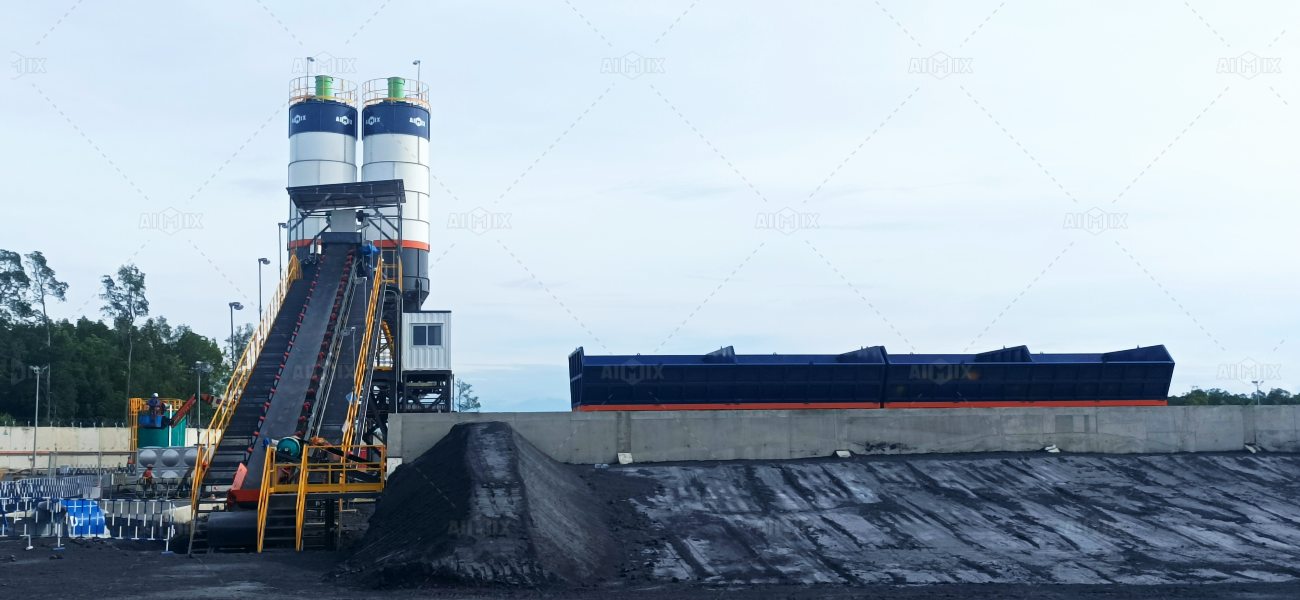
AJ-90 Stationary Concrete Batch Plant for Power Plant Project
- Delivery time: April 21, 2025
- Location: In Indonesia
- Customer needs: The customer required precision, efficiency, and reliability of concrete plant to ensure project continuity without delays or material loss.
- Our Solution: We supplied a 90m³/h batching plant equipped with integrated control system, precision feeding system and a high-performance SICOMA twin-shaft mixer.
- Outcomes: 30% reduction in startup time, 50% decrease in operational error rates, 20% increase in production continuity, 10% reduction in material waste, etc.

AJY-60 Mobile Batching Plant for Housing Projects
- Delivery time: March 31, 2025
- Location: In Ethiopia
- Customer needs: Boost production efficiency, achieve faster batching cyclies and complete the projects on time.
- Our solution: We offered a 60m³/h mobile concrete plant, with 1m³ Sicoma mixer for uniform and efficient mixing, and 2x100T cement silos. This cost-effective solution totally meets the customer’s requirements.
New vs. Pre-Owned Concrete Batching Plant: Which Is More Cost-Effective?
Investing in a concrete batch plant is a major decision for any construction business. Whether to choose a new or pre-owned plant depends on your budget, project scale, and long-term goals. While new plants offer advanced technology and reliability, pre-owned plants can reduce initial investment and allow faster deployment. The table below provides a clear comparison to help you make a decision.
| Factor | New Concrete Batching Plant | Pre-Owned Concrete Batching Plant |
|---|---|---|
| Initial Investment | $150,000 – $500,000 depending on capacity and automation | $70,000 – $200,000 depending on age and condition |
| Technology & Efficiency | Latest automation, energy-efficient, high production efficiency | Older models, lower automation, potentially lower output |
| Maintenance Costs | 2–5% of initial cost per year; warranty often included | 5–10% of purchase price per year; frequent repairs possible |
| Delivery Time | 4–12 weeks for manufacturing and shipping | Immediate or 1–2 weeks if locally available |
| Lifespan | 15–20 years with proper maintenance | 7–12 years depending on usage and condition |
| Suitable Project Types | Long-term, large-scale, frequent projects | Small, short-term, temporary projects, or trial use |
| Risk | Low; reliable performance, less unexpected downtime | Higher; downtime and spare parts availability may be an issue |
| Estimated ROI | 3–5 years typical; stable long-term profitability | 2–4 years potential, but long-term maintenance may reduce profitability |
Aimix offers brand-new concrete batching plants designed to match diverse project requirements while keeping the plant cost under control. By partnering with us, you gain a complete, end-to-end solution—from plant selection and installation to long-term support and operator training. We are committed to ensuring your investment remains safe, efficient, and profitable, enabling you to achieve sustainable growth in the concrete production industry.



